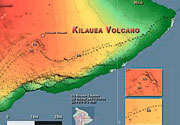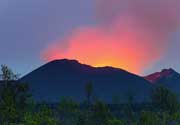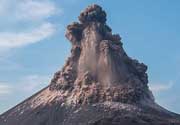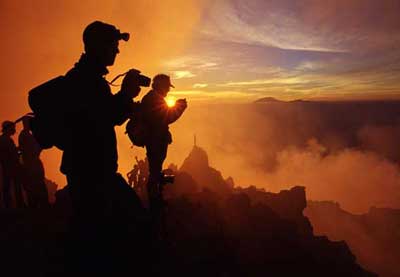Archived updates: April-October 2013:
Update Mon 28 Oct 09:03
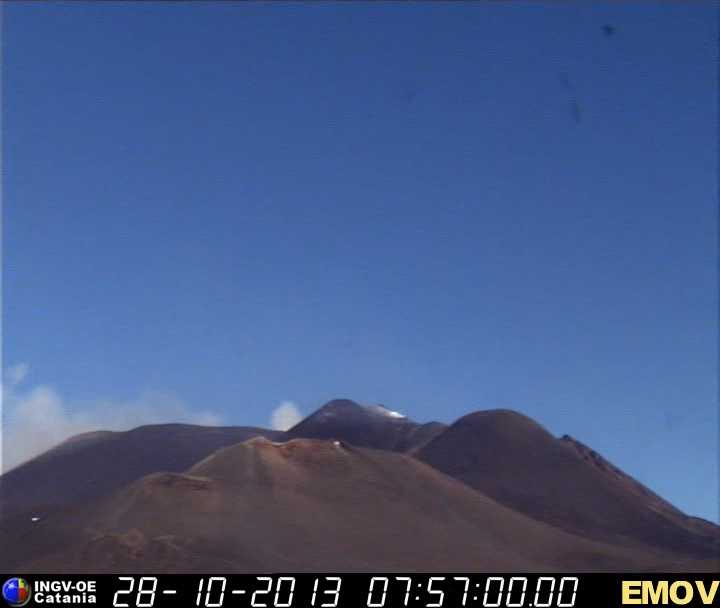
Etna's summit area this morning

Current tremor signal (ESLN station, INGV Catania)
The New SE crater has remained quiet since yesterday, although seismic activity remains above background. Strong degassing is visible from Bocca Nuova.
Update Sun 27 Oct 08:26
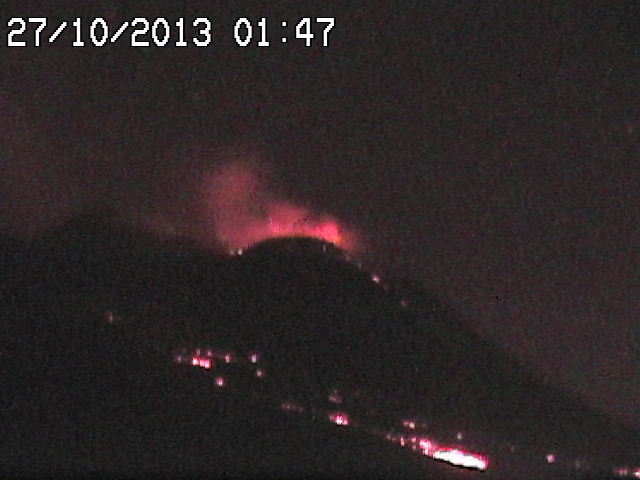
The New SE crater last night
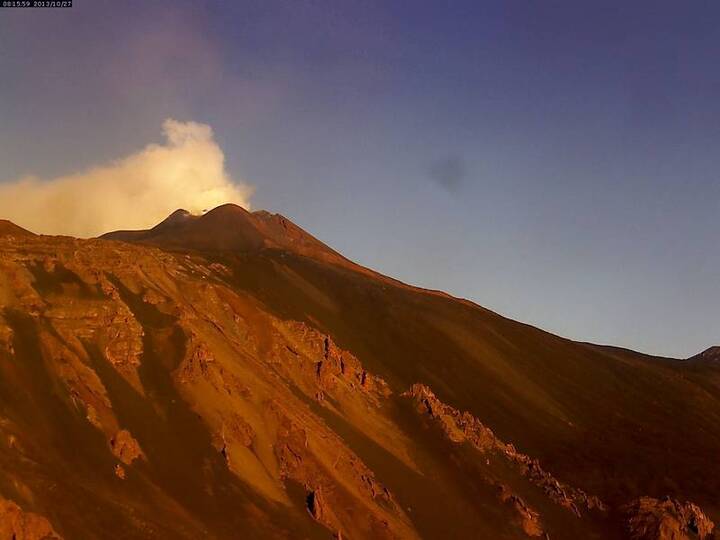
Etna's New SE crater this morning

Current tremor signal (ESLN station, INGV Catania)
Tremor has remained elevated and the New SE crater continued to produce weak strombolian activity and aliment the lava flow during much of the night. At the moment (Sunday morning), it is not clear if this activity is continuing.
Summary of yesterday's paroxysm:
The paroxysm yesterday ended around noon, after about 12 hours total of activity from the New SE crater which consisted in gradually increasing strombolian activity that merged into lava fountains after midnight. The lava fountaining reached its peak in the early morning hours (6-8 am local time) with heights of 4-600 m above the crater.
Strong ash and steam emissions continued to produce an impressive plume rising about 10 km above the volcano, i.e. to an altitude of 13 km (30,000 ft) and drifting SW. A relatively small lava flow was erupted from the saddle vent between the old and new SE crater, traveled south and then east into the upper Valle del Bove, reaching a length of approx. 0.5 km.
One of the most remarkable aspects of this eruption was that starting from 08:23 (local time), the NORTH-East crater activated also and produced a second ash plume.
It is still unclear whether the Bocca Nuova / Voragine craters participated in the activity as well, but it seems that they produced at least strong steaming and some ash as well in the later stages.
Time-lapse video from INGV's Montagnola webcam:
Paroxysm at the New SE crater (#14 in 2013)
Update Sat 26 Oct 08:48

Lava fountain from the New SE crater

Current tremor signal (ESLN station, INGV Catania)
Following a slow gradual build-up of increasing strombolian activity at Etna's New SE crater since yesterday, a new paroxysm is now in the progress, with high lava fountains, lava flows, and a tall ash plume.
You can follow this at live at
webcams.volcanodiscovery.com/Etna.
This would be the 14th paroxysm in 2013, after the series of 13 eruptions during Jan-April. The eruption was also preceded by a swarm of earthquakes.

Map of recent earthquakes under Etna

Depth vs time of earthquakes during the past 7 days
A swarm of magnitude 2-3 earthquakes has started yesterday beneath the northern flank at depths around 25-30 km:
Update Wed 23 Oct 12:16
After about 10 days of near complete quiet, a faint red glow was observed early on 22 Oct at the New SE crater. The origin of the glow seems to have been increased degassing from the summit vent and the at the fumaroles in the saddle between the old and New SE cone.
Update Thu 10 Oct 16:41

Current tremor signal (ESLN station, INGV Catania)
The capricious Sicilian lady seems undecided what to do. The sporadic strombolian activity from the New SE crater has last been observed (to our knowledge) about 2 days ago. Temor is currently low, and generally bad weather doesn't help detailed direct observations.
Update Mon 07 Oct 23:25
Sporadic weak explosions from the New SE crater have continued. Currently, there are no signs of increasing activity.
Update Sun 06 Oct 12:17
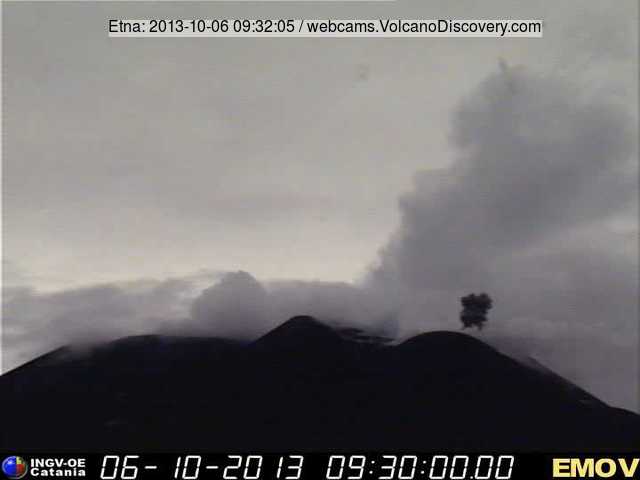
Ash emission from Etna's New SE crater this morning

Current tremor signal (ESLN station, INGV Catania)
The New SE crater has resumed weak, sporadic strombolian activity with small ash emissions. This goes along with an increase of the tremor signal today. The situation is certainly worth following!
Update Sun 29 Sep 14:26

Current tremor signal (ESLN station, INGV Catania)
Activity at the New SE crater has eased for now. Some occasional small strombolian explosions were last noted about 2 days ago. Tremor amplitude has decreased slightly as well.
Update Thu 26 Sep 10:30
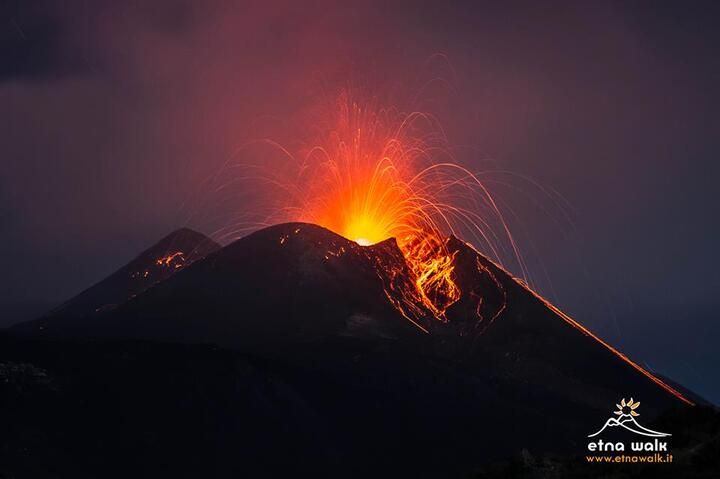
Explosion yesterday evening (25 Sep) from Etna's New SE crater (photo: Marco Restivo / www.etnawalk.it)
Strombolian activity continues at the New SE crater. Whether (and when) this might lead to another paroxysm is unclear. The volcanic tremor signal is still relatively low.
Update Tue 24 Sep 18:33

Ash emission from Etna's New SE crater this morning

Current tremor amplitude (ECPNZ station, INGV Catania)
Weak strombolian activity and ash emissions continue from the New SE crater. Tremor amplitude continues to rise very slowly.
Continuing ash emissions, slowly rising tremor
Update Sun 22 Sep 21:27
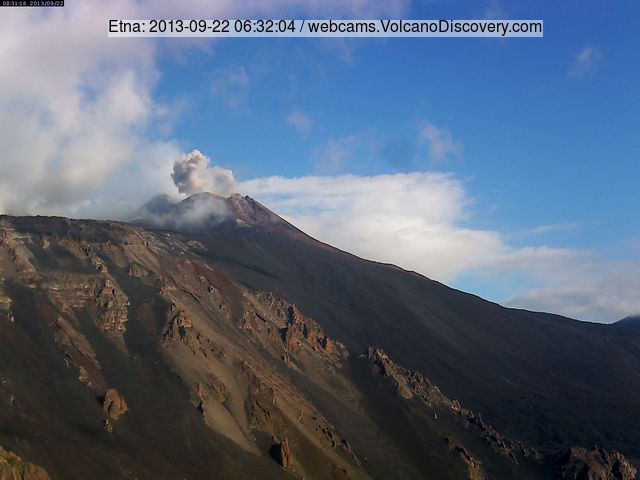
Small ash eruption from the New SE crater this morning (Etna-Trekking webcam)

Current tremor amplitude (ECPNZ station, INGV Catania)
Sporadic small ash emissions have reappeared from the New SE crater during the past days, although weather conditions did not often allow direct observation. Since about 4 days ago, tremor has been showing a slowly rising trend, although it is still at low levels.
Weak strombolian activity in both Bocca Nuova and NSEC
Update Sat 07 Sep 12:24
Last night, very deep-seated strombolian activity could be observed from both the Bocca Nuova and the New SE crater. This indicates that (similarly to early this year) magma has risen into the upper parts of the conduits beneath both vents. It might only be a question of time until this activity increases (perhaps even towards new paroxysms) and maybe becomes focused on one of the two craters.
New ash emissions from New SE crater
Update Fri 06 Sep 11:00
Since a few days ago, the New SE crater has been producing weak ash emissions occasionally. Whether this is the precursor to more vigorous activity and when this will occur, is difficult to say at the moment, but it is a sign that the volcano is waking up from the slumber it has been in during the past 4 months.
Update Sun 26 May 11:59
Etna today is free of clouds, but strong winds with gusts up to 70 km/h speed prevail. No further significant earthquakes occurred. The only activity remains degassing, and occasional small explosions, not visible, deep inside Bocca Nuova, based on seismic observations (OPEC).
Update Sat 25 May 18:26
The earthquake swarm on the SE flank seems already to have come to an end. No eruptive activity is currently occurring at the summit craters. Strong wind and cloud cover prevented a field visit today.
Shallow earthquake swarm near Zafferana
Update Fri 24 May 22:24
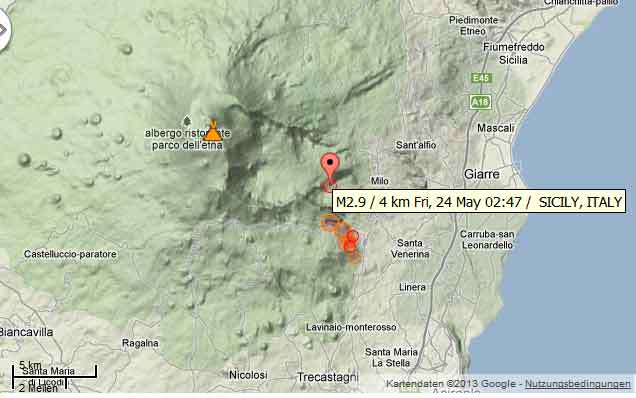
Map of recent earthquakes under Etna
A swarm of shallow (3-6 km depth) earthquakes including several felt ones (magnitudes 2.9-3.5) occurred yesterday and today under the SE flank near Zafferana town. So far, no other unusual signs of activity have been reported, but the swarm could indicate something in the making, and the monitoring agency INGV is certainly following these events closely.
Update Thu 23 May 10:42
Etna has been almost completely quiet since a brief episode of strombolian activity at the New SE crater in early May. Apart from a few occasional deep-seated explosions in Bocca Nuova detected only on seismic signals (INGV personal communication), the volcano has not shown other surface activity than degassing.
Ash emissions and strombolian activity from New SE crater
Update Thu 02 May 08:49

Tremor signal (ESLN station, INGV)
After 3 days of quiet, strombolian activity has resumed at the New SE crater yesterday. This has been accompanied by a rise of the tremor signal. Most likely, Etna is preparing again for yet another paroxysm in the near future.
13th New SE crater paroxysm
Update Sat 27 Apr 20:10

Lava fountains from the New SE crater (Etna Trekking webcam)
The 13th New SE crater paroxysm is occurring this evening. Tall lava fountains rise from the central vent of the cone, and a lava flow has rapidly descended the slope into Valle del Bove. A dense tephra plume is rising several kilometers above the volcano and drifting to the NE where ash- and lapilli fall is occurring.
Update Sat 27 Apr 19:26
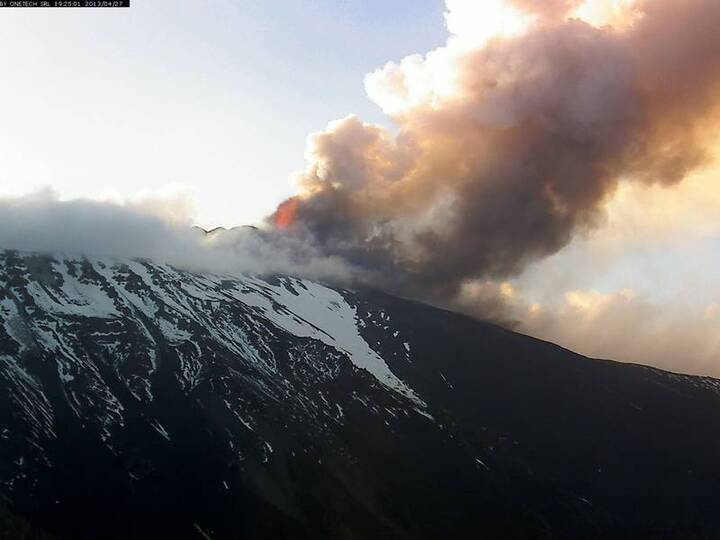
View from Schiena dell'Asino (Etra Trekking webcam)
Judging from the webcam images, lava fountains have now started, i.e. the main phase of the paroxysm has begun. A denser plume is rising from the New SE crater. Tremor continues to climb steeply.
Update Sat 27 Apr 18:24
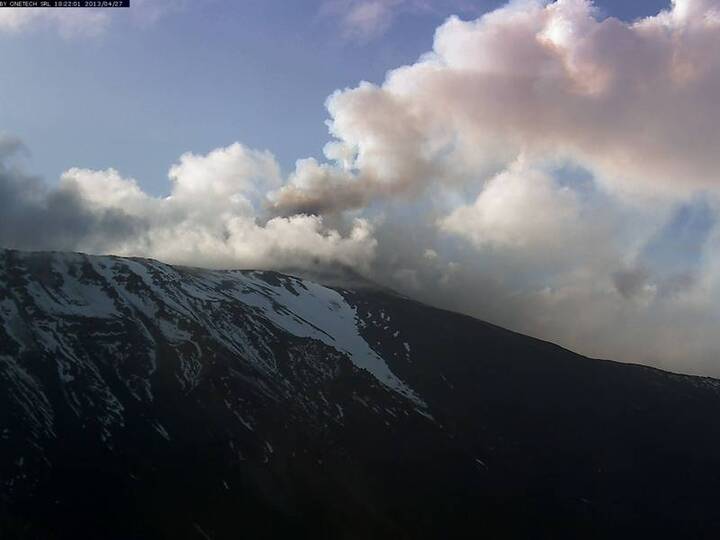
View from Schiena dell'Asino (Etra Trekking webcam)

Tremor signal (ESLN station, INGV)
Activity has continued to increase with near continuous strong strombolian explosions from the New SE crater, but it seems that the climax of the paroxysm with sustained lava fountains is yet to come, possibly very soon. The tremor has reached higher levels than during most of the previous paroxysms, but still rises.
13th New SE crater paroxysm ?
Update Sat 27 Apr 09:29

Tremor signal (ESLN station, INGV)
Strong strombolian-type explosions, probably accompanied by effusion of small lava flows continued all night from the New SE crater and produced strong glow visible through the fog around the summit. Rumblings were heard in nearby villages, but fog and clouds have been preventing detailed observations. The tremor has risen to high levels comparable with those during previous paroxysms, then decreased a bit and seems now to increase again. This pattern looks very similar to the 12 April paroxysm, one which was preceded by a long phase of very strong explosions, that culminated in lava fountaining only after the tremor had reached its peak.
Update Sat 27 Apr 01:01
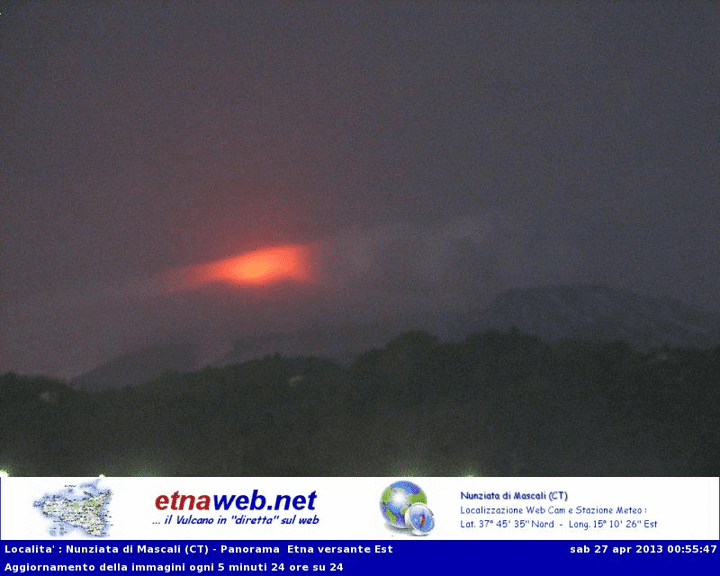
Glow from Etna (EtnaWeb webcam)

Tremor signal (ESLN station, INGV)
Activity is now increasing towards a new paroxysm from the New SE crater.
Update Fri 26 Apr 20:29
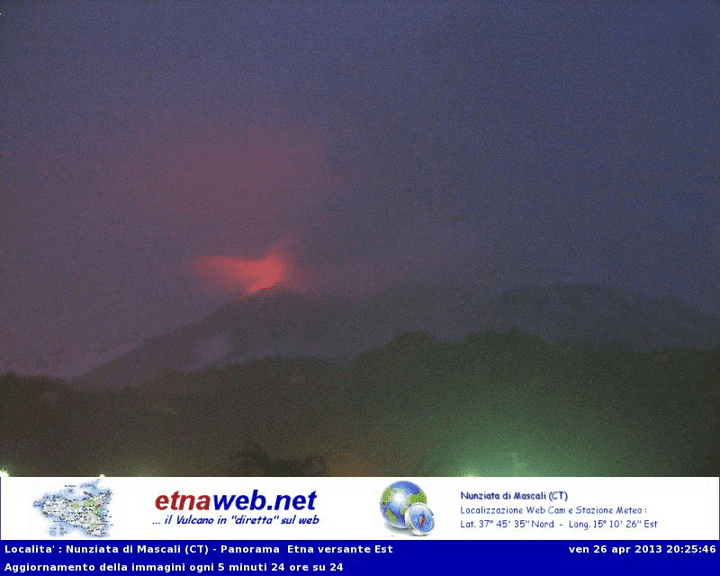
Webcam image of Etna with glow from the NSEC crater (EtnaWeb webcam)
Activity and tremor continue to rise, and it looks more and more certain that a new paroxysm is about to occur in the next hours or so.
Update Fri 26 Apr 19:18
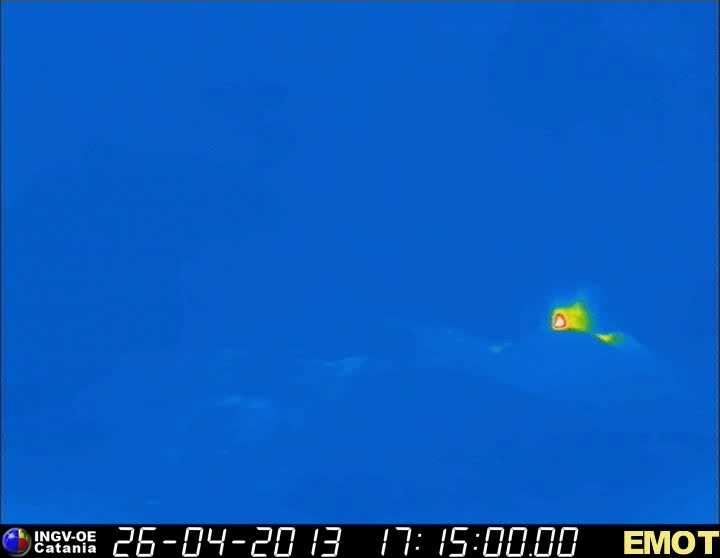
Thermal image of the New SE crater (INGV Catania)

Tremor signal (ESLN station, INGV)
It seems that a new paroxysm is in the making at the New SE crater. Strombolian activity continues from the summit vent, and the tremor has started to rise as it did during the previous events.
Update Fri 26 Apr 10:23
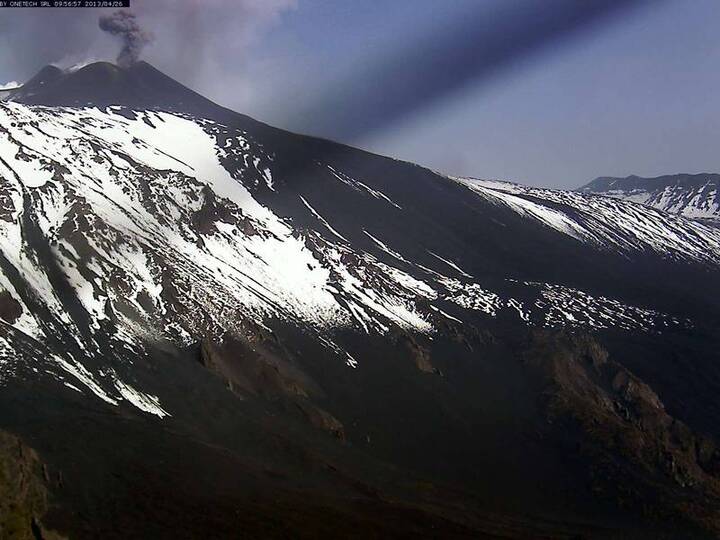
Ash emission from Etna's New SE crater (Etna Trekking webcam)
Relatively intense strombolian activity and ash emissions continue at the New SE crater. INGV tremor data seems currently not to be available to see whether this is rising or not, and might be the beginning of another paroxysm. A steam and ash plume is rising about 1 km above the volcano.
Ash emissions and strombolian activity from New SE crater
Update Thu 25 Apr 17:05

Ash emission from Etna's New SE crater this morning (INGV webcam)

Ash emission from Etna's New SE crater this afternoon (INGV webcam)
Ash emissions and strombolian activity has continued since the last paroxysm and increased in frequency yesterday and today. The tremor signal has remained low, not suggesting that the volcano is in for another paroxysm at the moment, something quite different (so far) from the activity preceding the past paroxysms.
12th New SE crater paroxysm
Update Sat 20 Apr 22:37
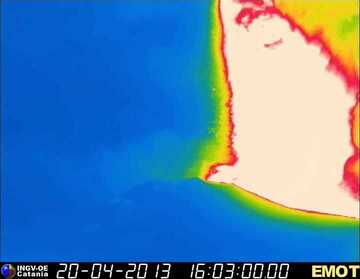
Thermal image of the lava fountains from the New SE crater (INGV Catania)
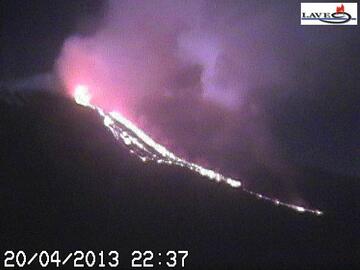
Lava flows from the New SE crater after the paroxysm

Tremor signal (ESLN station, INGV)
After only 2 days since the previous eruption, the 12th paroxysm of the New SE crater occurred this afternoon. Following a build-up phase of strombolian explosions since yesterday, the eruption culminated with tall lava fountains and lava flows.
At the end of the eruption, at least 2 pyroclastic flows towards the Valle del Bove were reported to have formed. After the eruption, lava flows continue to be active from vents at the base of the cone and descend towards Valle del Bove.
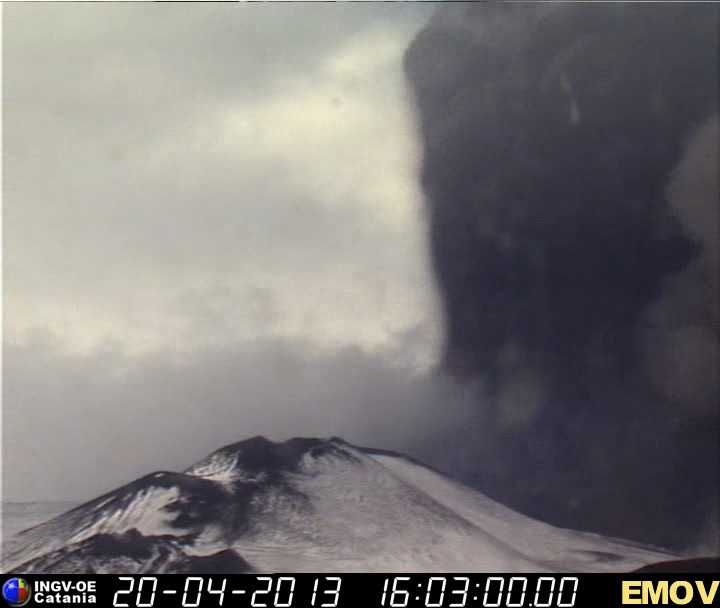
Montagnola webcam (INGV)

Montagnola webcam (INGV)
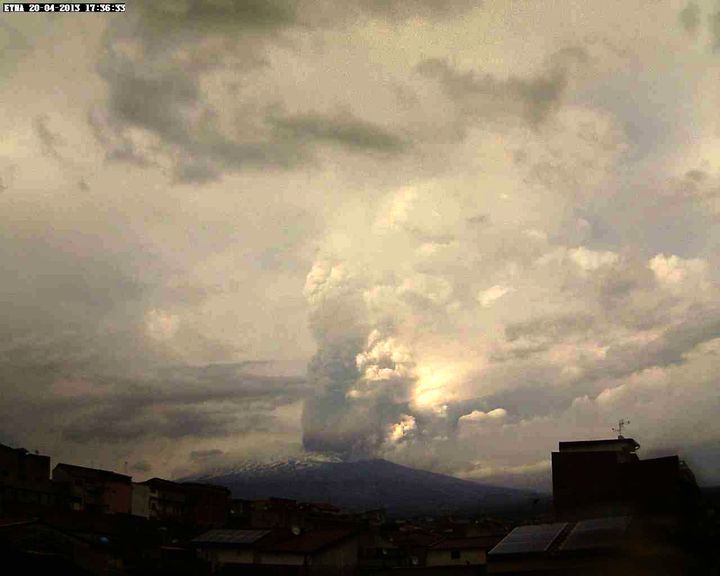
View of the plume from Paterno
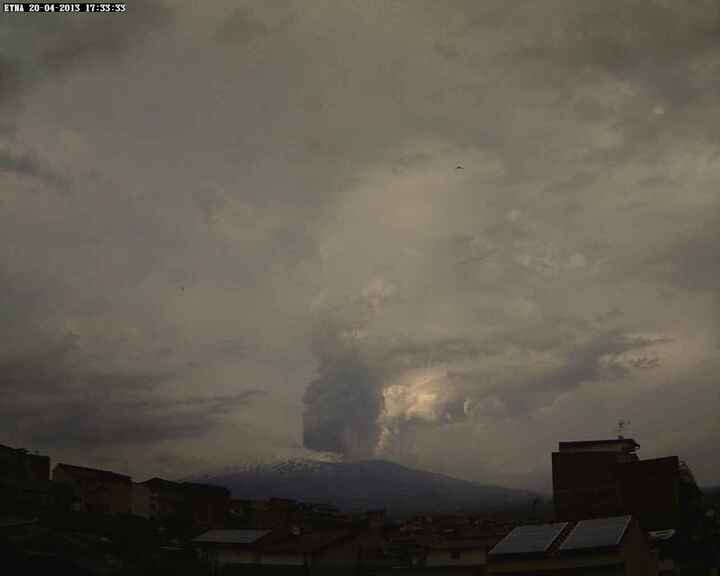
View of the plume from Paterno
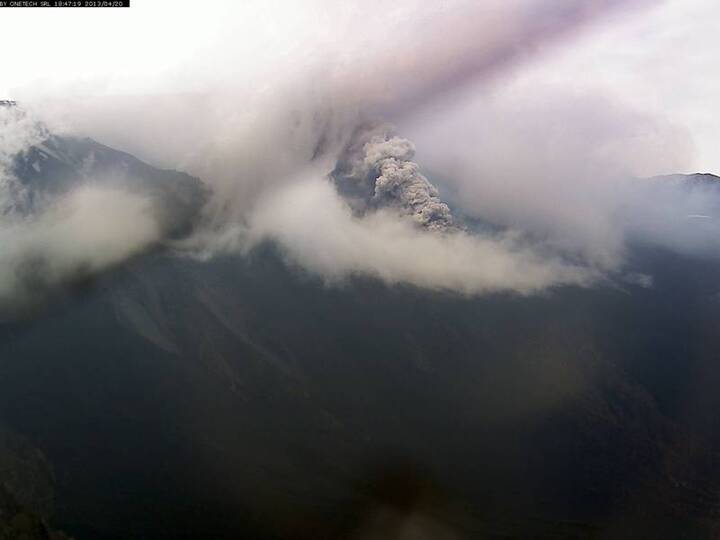
Pyroclastic flow, view from Schiena dell'Asino
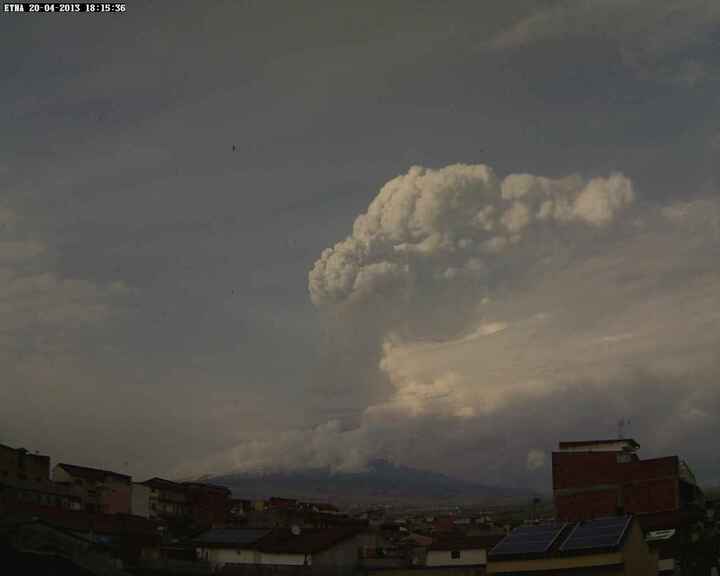
View of the plume from Paterno
Some webcam images of the 20 April paroxysm:
Update Sat 20 Apr 09:29
Weak explosive activity persists at the New SE crater, which has been producing small ash emissions throughout the day yesterday. During the night, a small lava flow emerged from the fissure that cuts through the cone on its eastern flank.
11th New SE crater paroxysm
Update Thu 18 Apr 19:18
The 11th paroxysm from the New SE crater occurred as expected today. As during the previous eruption, the build-up phase with increasing strombolian activity was relatively long. The peak phase itself when activity culminated in lava fountains was comparably short.
New paroxysm of the New SE crater in the making
Update Thu 18 Apr 10:48
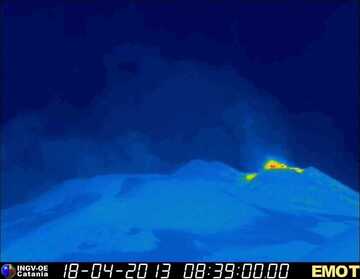
Current thermal webcam image of the New SE crater (INGV Catania)

Strombolian activity during the night (Radiostudio7 webcam)

Current tremor signal (ESLN station, INGV Catania)
It seems likely that another paroxysm is in the making at the New SE crater: Strombolian explosions have continued throughout the night and this morning, and have been intensifying. Lava seems to have appeared at several vents on the fissure cutting through the New SE crater and the tremor signal is steeply rising.
Strombolian activity from New SE crater
Update Wed 17 Apr 11:05
New activity has started from the New SE crater last night, when incandescent degassing vents were visible at the crater. This activity has progressively increased during the night and produced strombolian bursts during the second half of the night. Tremor has been showing a slow increase.
Update Sat 13 Apr 16:56
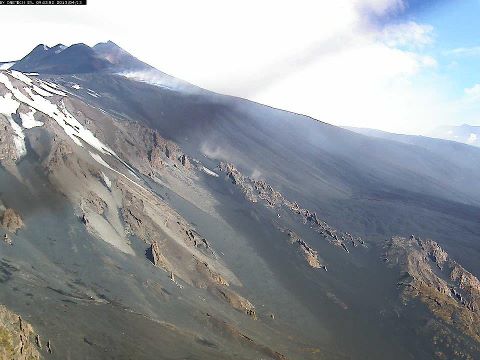
Webcam image of the New SE crataer with the suspected new vent (bluish degassing) at its base
Following yesterday's paroxysm, it seems that a new effusive vent has opened at the SE base of the New SE crater.
10th New SE crater paroxysm
Update Fri 12 Apr 18:18

Current tremor signal from Etna (ETFI station, INGV Catania)
The 10th paroxysm of the New SE crater has ended after a long phase of strong explosions, lava flows, lava fountains and a tall ash plume.
The style of this latest eruption was distinctively different from the preceding ones and suggests that Etna is in a period of change. Two pyroclastic flows that formed during the eruption, a smaller one at about 10:35 and a bigger one shortly before 11:00. They could have been caused by to the collapse of parts of the crater wall of the New SE crater.
The rise of activity has been gradual over several days, and while tremor peaked around midnight, then dropped a bit, the eruptive activity itself continued to increase and first peaked today:
- two phases of lava flows were produced, one at the end of the night and one at noon. The emergence of the lava flow caused a portion of the inner wall to collapse, which in turn produced the pyroclastic flows.
- strong single explosions merged into sustained lava fountains first during the early afternoon, after the tremor had started to decrease a bit. This activity was accompanied by a dense and tall plume of lapilli and ash, typical for Etna's paroxysms.
Pyroclastic flows during the 12 April paroxysm
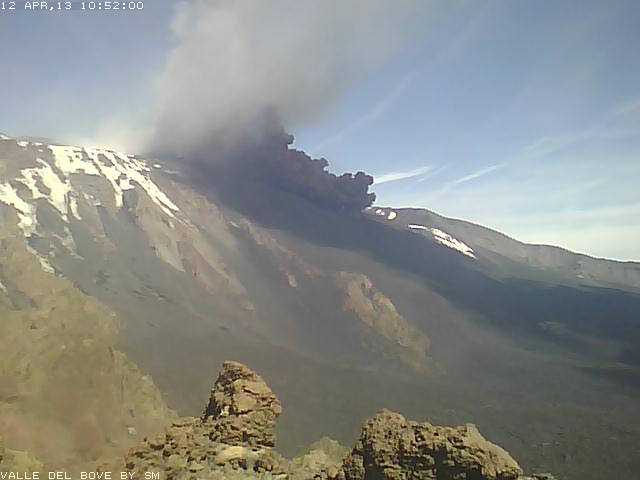
Radiostudio7 webcam image from Schiena dell'Asino showing a pyrocalstic flow

Etna-Trekking webcam image from Schiena dell'Asino showing a second pyrocalstic flow shortly after
At the end of the eruption, partial collapse of the New SE crater's walls triggered pyroclastic flows that descended towards and partly into Valle del Bove. Here are two webcam images (thanks to
Geoforum.fr):
Update Fri 12 Apr 10:32
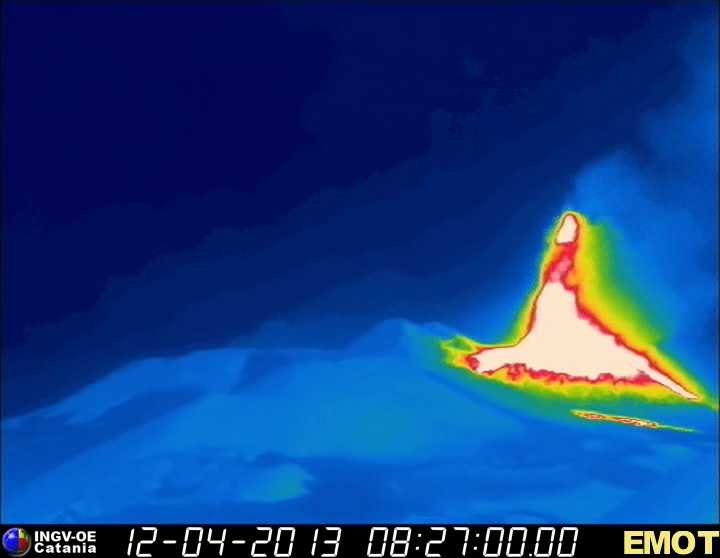
Thermal image of the New SE crater (INGV Catania)
The eruption is still intensifying. Strombolian explosions are about to merge into lava fountains.
Eruption continues
Update Fri 12 Apr 07:51
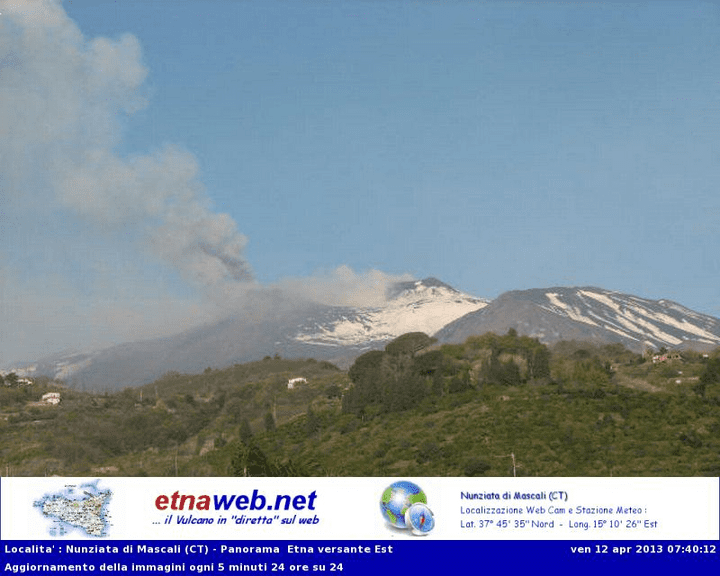
Webcam image from the NE (etnaweb)
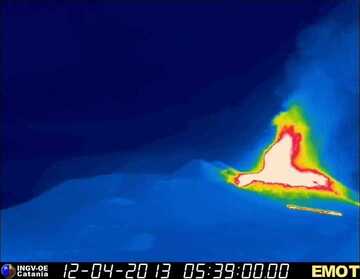
Thermal image of the New SE crater (INGV Catania)

Current tremor signal from Etna (ETFI station, INGV Catania)
The eruption continued all night with strong strombolian explosions and the slow effusion of one or several lava flows from the eruptive fissure to the east. The explosions have been accompanied by loud bangs that rattled windows in many kilometers away and could be felt until the Ionian coast.
The volcanic tremor has continued to rise to very high levels (as high as during the most powerful paroxysms of the past weeks) where it has now been stagnating for the past hours. This paroxysm has been quite different from most others: It seems that so far, no true lava fountaining has occurred, rather ongoing strong explosions at a duration that is truly amazing.
Update Thu 11 Apr 19:22
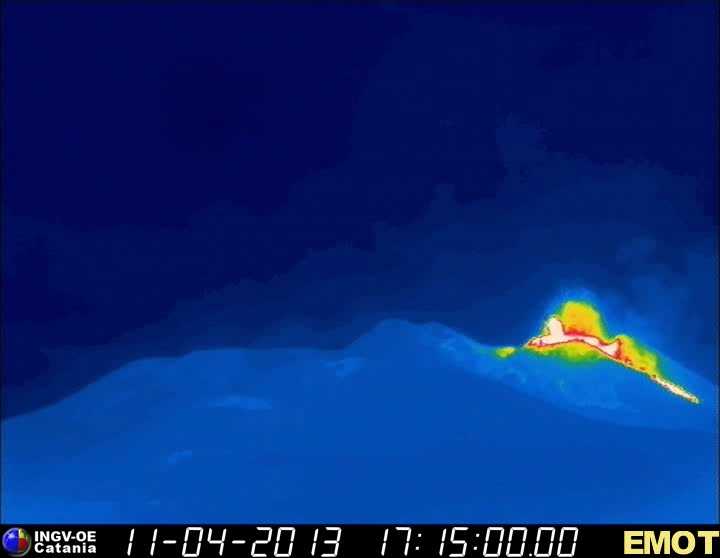
Thermal image of the New SE crater (INGV Catania)

Current tremor signal from Etna (ETFI station, INGV Catania)
Several vents on the fissure cutting through the cone are now active and produce strombolian activity and/or small fountains (lower vents) feeding a lava flow that starts to descend eastwards towards Valle del Bove.
Update Thu 11 Apr 18:47
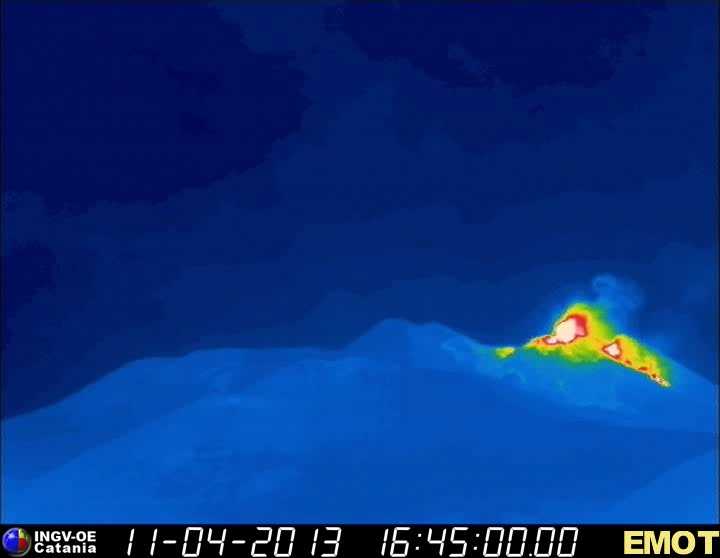
Thermal image of the New SE crater (INGV Catania)

Current tremor signal from Etna (ETFI station, INGV Catania)
This time, Etna is taking it really slowly to build up to the presumed next lava fountaining phase from the New SE crater (paroxysm). Tremor keeps rising, and strombolian explosions slowly increase from the summit vent of the cone.
Begin of the paroxysm
Update Thu 11 Apr 14:59

Thermal image of the New SE crater (INGV Catania)

Current tremor signal from Etna (ETFI station, INGV Catania)
Strombolian activity at the New SE crater is intensifying and volcanic tremor is now steeply rising. The 10th paroxysm seems to be about to start.
Update Thu 11 Apr 07:33
This time, Etna seems a bit undecided what to do. Strombolian explosions from the New SE crater continued throughout the night and were sometimes quite intense. Tremor has risen a lot (about 10 times background), but has now been stagnating for a while.
Maybe we are in for something different this time, or, more likely, the expected new paroxysm will take longer than the previous ones to build up.

Current tremor signal from Etna (ETFI station, INGV Catania)
10th paroxysm in the making
Update Wed 10 Apr 23:33

Strong strombolian activity from the New SE crater

Tremor signal (ETFI station, INGV)
It looks almost certain that we are about to "witness" another paroxysm from the New SE crater: Strombolian explosions continue to increase and the tremor signal has started to rise sharply. (Next update tomorrow morning... )
Update Wed 10 Apr 20:59
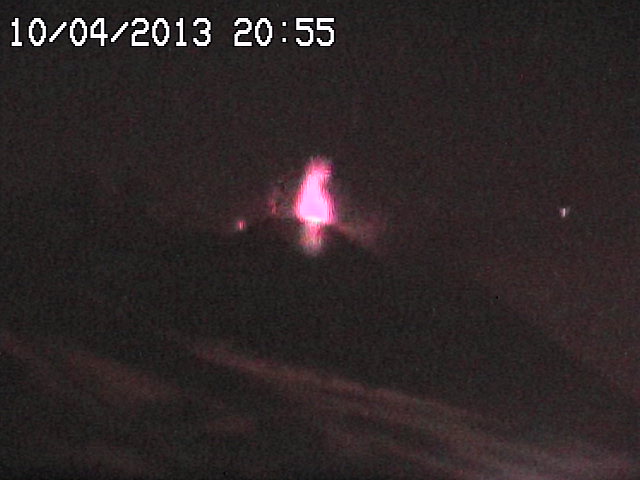
Strombolian explosion from the New SE crater

Current tremor signal from Etna (ETFI station, INGV Catania)
Strombolian activity at the New SE crater and tremor continue to rise slowly. It looks more and more likely that a new paroxysm could occur (perhaps very) soon.
Continuing ash emissions and explosions
Update Wed 10 Apr 09:57

Ash emission from Etna's New SE crater (INGV webcam)

Current tremor signal from Etna (ETFI station, INGV Catania)
Strombolian explosions and relatively strong ash emissions from the New SE crater have continued throughout yesterday and the night, and seem to be gradually becoming more intense.
However, this current behavior of Etna is a quite different from the usual more or less short build-up of activity the cone showed preceding the recent paroxysms. The tremor is slowly increasing.
It will be interesting to see what comes next, another paroxysm, or something different? Etna is always good for surprises!
Update Tue 09 Apr 11:39
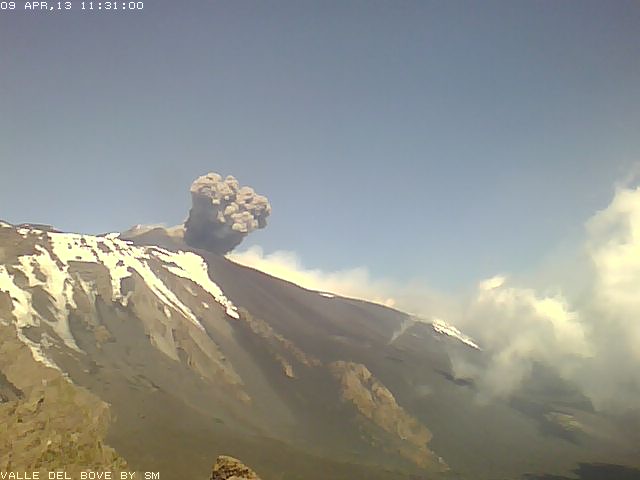
Explosion from the New SE crater

Current tremor signal from Etna (ETFI station, INGV Catania)
Relatively strong ash explosions continue to occur from the New SE crater. At the same time, the tremor signal is rising - maybe we're about to witness the start of a new paroxysm?
Ash emissions and strombolian activity from New SE crater
Update Tue 09 Apr 10:22
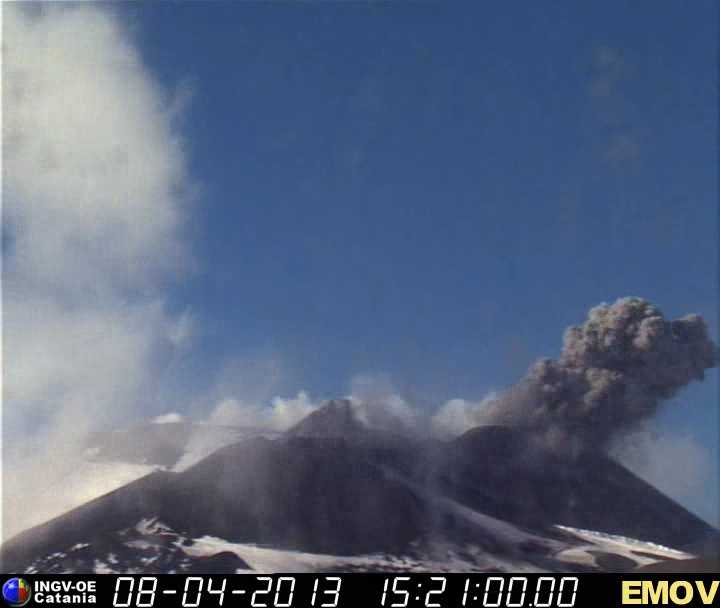
Ash emission from Etna's New SE crater yesterday afternoon (INGV webcam)

Current tremor signal from Etna (ETFI station, INGV Catania)
New activity has started yesterday afternoon from the New SE crater. Several relatively intense explosive ash emissions were observed from the summit vent of the cone. They produced dense ash plumes rising about 200 m. More explosions occurred during the night, separated by intervals varying from 20 minutes to about 2 hours, during which strong degassing continued and the fumarolic area at the crater rim remained incandescent.
The tremor showed a light increase during the night, but it is not clear at the moment, if this is already a precursor to yet another paroxysm.
Update Wed 03 Apr 23:49

Radiostudio7 webcam image of Etna's New SE crater with still active lava flows
Some lava continues to flow from vents on both the south and the north side of the New SE crater it seems.
Lava fountains during the 9th paroxysm
Update Wed 03 Apr 23:45
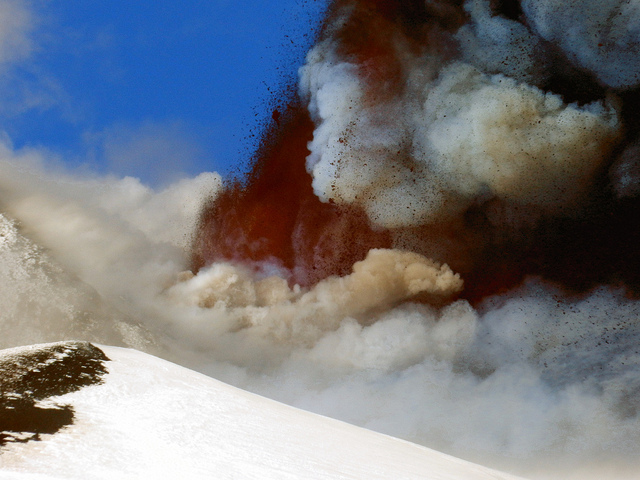
Lava fountains during the paroxysm (Photo: Boris Behncke)

Tremor signal showing the relatively slow build up and long peak phase of the eruption
The paroxysm indeed took a while to reach a relatively long-lived peak phase with high lava fountains, after building up slowly with large explosions of bursting liquid lava bubbles.
Boris reports: "After a few hours of seeming a bit undecided whether to really let loose or not, Etna's New Southeast Crater finally did let loose, and blood-red lava fountains shot hundreds of meters into the blue Sicilian sky. Taken at 14:22 GMT (=local time -2) from Monte Vetore, about 6.4 km to the southwest."
Source:
Boris'Behncke on FlickrUpdate Wed 03 Apr 16:07
After an hour or so of remaining stable, activity has picked up again to increase!
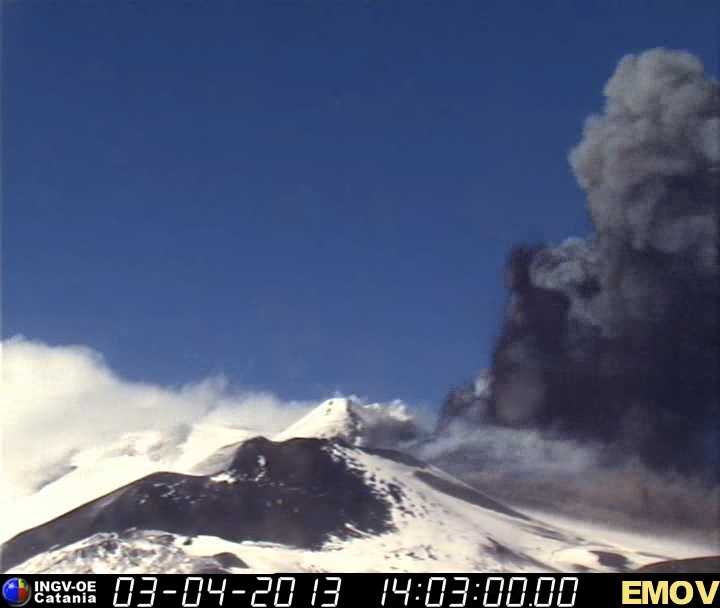
Lava fountains now 3-500 m tall from the New SE crater (INGV webcam)
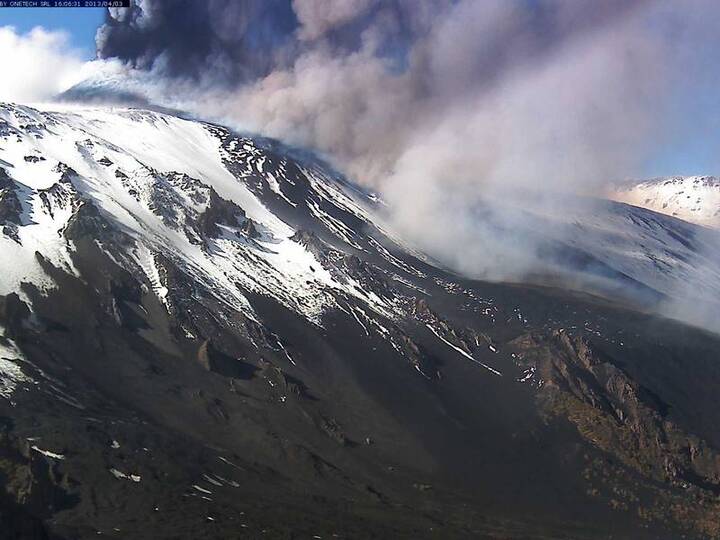
View from Schiena dell'Asino (Etra Trekking webcam)
9th paroxysm of New SE crater
Update Wed 03 Apr 15:51
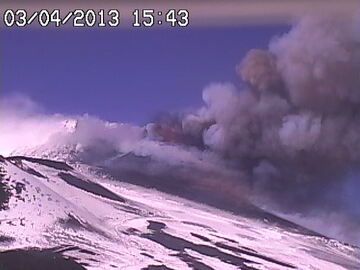
Lava fountain from the New SE crater (Radiostudio7 webcam)
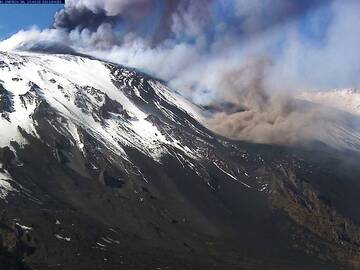
View from Schiena dell'Asino (Etra Trekking webcam)

Current tremor signal from Etna, about 100xnormal value (ETFI station, INGV Catania)
The 9th paroxysm from the New SE crater in 2013 is occurring this afternoon. It seems it now has reached its peak phase with lava fountains, and lava flows from the fissure vent of the New SE cone descending into Valle del Bove. It seems that the fountains are much smaller ("only" 2-300 m) compared to those of the last eruption on 16 March, but the peak phase lasts longer this time.
Update Mi 03 Apr 10:58
Tremor at the New SE crater (ETFI signal, Torre del Filosofo station) continues to rise. It seems now almost Certain that a new paroxysm is in the making.

Tremor signal (ETFI station, INGV)
Rising tremor - begin of a new paroxysm?
Update Wed 03 Apr 08:01
The tremor has started to rise,- possibly this could be the begin of a new paroxysm at the New SE crater. Clouds in the summit area prevent direct view to confirm if any activity is occurring there at the moment.

Current tremor amplitude (IGN)
Etna quiet, comment on sandstone xenoliths from last paroxysm
Update Tue 02 Apr 10:01

Current view of Etna (INGV webcam)
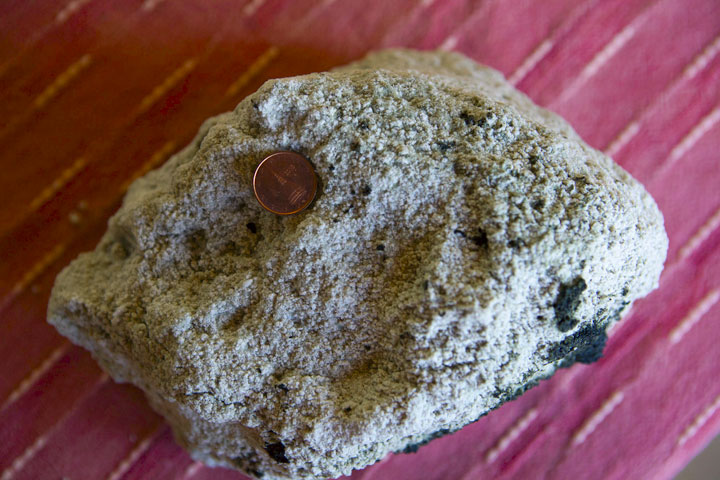
Sandstone xenolith from the 16 Mar paroxysm
More than 2 weeks have passed since the last eruption from the New SE crater and it seems more and more likely that something in the volcano's current eruptive behavior once again is about to change. Of course, it would also not come as a surprise if another paroxysm occurred in the near future.
Sandstone xenoliths from 16 Mar eruption:
Closer inspection of the "white lava" reported in yesterday's news revealed that these were so-called xenoliths, i.e. no lava at all, but pieces of sedimentary rock from strata underlying the volcano brought up by the rising magma. In this case, they are pieces of barely compacted beach sandstone, similar to the xenoliths ejected during the flank eruptions in 2011 and 2012, which are believed to have trapped a different (so-called eccentric) shallow magma chamber beneath the volcano. To find such xenoliths as produces of eruptions from the SUMMIT craters is highly unusual and could (*speculation*) indicate that the latest, violent, eruptive episode has actually involved a different magma reservoir as well.
Fresh snow has now covered much of the bombs from the recent eruption.
First visit to our site? If you havn't done it yet,
download the Volcanoes & Earthquakes app to get one of the fastest volcano news online:
Android |
IOS


















































































